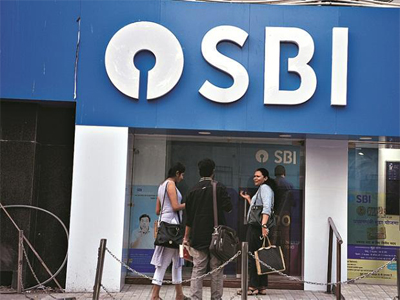SBI beats estimates, profit before tax surges 65.7% in Dec quarter

State Bank of India (SBI) put up a better-than-expected show during the December 2019 quarter (Q3FY20), on most operational parameters. The exception was on the loan growth front, possibly on account of the overall slowdown in the economy.
Good recovery from the Essar Steel stressed loan account provided an impetus to the Q3 performance. However, gains were restricted due to the DHFL account turning bad.
The stock rose 2.5 per cent to Rs 318.55 at close on Friday, even as the benchmark Sensex fell 0.5 per cent.
The bank posted 22.4 per cent year-on-year (YoY) growth in net interest income to Rs 27,779 crore. Profit before tax surged 65.7 per cent from the year before to Rs 10,970 crore, much ahead of Street expectations.
In a Bloomberg poll, analysts had pegged these two metrics at Rs 25,587 crore and Rs 9,046 crore, respectively. Net profit grew 41.2 per cent to Rs 5,583 crore, driven partly by the lower corporation tax rates.
SBI Chairman Rajnish Kumar said the performance on all parameters was satisfactory. “A large housing finance company (DHFL) account slipped into the non-performing asset (NPA), or bad loan category. There was also recovery (around Rs 11,000 crore) in Q3 from resolution of a large steel company (Essar Steel). The economic slowdown is impacting the profit, though not the profitability,” he added.
The bank’s corporate loan book declined by about 0.5 per cent YoY. The retail (to small lenders) book grew 9.7 per cent, a bit lower lower than the 12.5 per cent growth in Q2.
A 17 per cent YoY rise in the foreign loan book helped advances grow 6.8 per cent to Rs 23 trillion, also lower than the 9 per cent growth during Q2.
The recovery from the Essar Steel account led to the bank adding back the accrued interest and provisioning made earlier. It had provided 100 per cent provisioning on its balance sheet for loans given to Essar Steel.
With this, operating profit surged 44.3 per cent YoY to Rs 18,223 crore, against analysts’ expectation of Rs 15,595 crore. Net interest margin for domestic operations improved by 62 basis points (bps) over the year to 3.59 per cent.
Though, in absolute terms, the provisioning increased by around 21 per cent YoY, its credit cost (provisioning as a percentage of the loan book) fell to 1.8 per cent, from 1.98 per cent in the earlier quarter. In fact, this was the lowest in many quarters despite higher slippages or loans turning bad.
Cyrus Dadabhoy, vice-president at Centrum Broking, said: “Slippages, excluding the stressed housing finance account, are in line with expectations.”
On a yearly basis, fee income rose 19.3 per cent to Rs 5,635 crore and deposits by 9.9 per cent to Rs 31.1 trillion.
The share of the low-cost current and savings accounts in total deposits declined to 44.7 per cent at the end of December, from 45.2 per cent a year ago.
Gross NPAs (or non-performing assets) fell to 6.94 per cent (as a proportion of advances) in Q3, from 7.19 per cent in Q2 and from 8.71 per cent a year before. The net NPA ratio at 2.65 per cent was also down 130 bps YoY and 14 bps sequentially.
Besides slippage in the DHFL account (Rs 7,000 crore), the bank also recognised NPAs from its agriculture portfolio worth Rs 2,900 crore. Debt-waiver schemes impacted recoveries and renewing of loans in the sector, the chairman said.
Going ahead, the management says it is confident of good improvement in asset quality, both in slippages and provisioning. It has lowered its credit growth forecast to up to 10 per cent, from 10-12 per cent earlier, mainly reflecting weak demand for corporate credit. Rajnish Kumar also said it would now be difficult to achieve the 0.9-1 per cent return on assets target for FY21.
Dadabhoy also believes SBI’s asset quality will improve and the overall operating performance remain strong.
The provision coverage ratio improved to 81.73 per cent, up 710 bps YoY and 50 bps sequentially. The capital adequacy ratio was 13.73 per cent at end-December, from 13.59 per cent at end-September.

.webp)
.webp)
.webp)
.webp)
.webp)
.webp)
.webp)
.webp)
.webp)
.webp)





